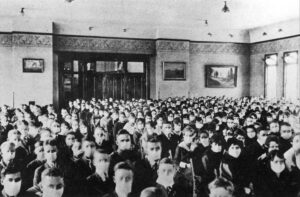Many of Wisconsin’s rural towns are more walkable than suburbs

Walk Score is a company which generates eponymous scores for towns and addresses based on how many staples of everyday life you can walk to. A score of 0 means nothing is in walking distance. An entirely walkable community scores 100. New York City scores 88, Los Angeles 69, Houston 47, Scottsdale 32.
I grew up in Bardolph, Illinois with a walk score of 7. We lived within walking distance of three places where I could legally spend money–the post office and two pop machines. Bardolph wasn’t always this way. My great-aunts could recall catching the train to the county seat. During my mom’s childhood, the village still had a grocery store, pool hall, schools, and two churches. The high school consolidated in 1973, and the grade school merged with Adair in 1979. The Presbyterian church closed in the early 1990s, while the Methodist church lingered just a few years longer. Last time I visited, the pop machines were gone, and the post office was only staffed 2 hours a day.
Bardolph is a little closer to oblivion than some of its neighbors. But all of McDonough County’s small towns–Adair (walk score: 7), Good Hope (10), Industry (8), Prairie City (17)–are well along that same trajectory.
These low walk scores aren’t a consequence of car-centric design. You could walk to the furthest corners of each in 15 minutes, possibly even on a sidewalk. There is just almost nowhere left to walk to.
This being my experience of rural life, I was surprised to encounter many healthy small towns in Wisconsin, some of which are even thriving.

 In another
In another  Here we are . . . . It’s January 22, 2022. It’s windy outside. Cold, yet blindingly bright. What snow we had in Milwaukee County has mostly melted, yet winter isn’t even a month old at this writing. Classes resume for the “spring” semester on Monday, the 24th of January 2022, having been delayed for a week so Marquette University can address the burgeoning Omicron variant of the COVID virus. It is this writer’s second “spring” semester at Marquette University Law School and the second spent in the global COVID pandemic.
Here we are . . . . It’s January 22, 2022. It’s windy outside. Cold, yet blindingly bright. What snow we had in Milwaukee County has mostly melted, yet winter isn’t even a month old at this writing. Classes resume for the “spring” semester on Monday, the 24th of January 2022, having been delayed for a week so Marquette University can address the burgeoning Omicron variant of the COVID virus. It is this writer’s second “spring” semester at Marquette University Law School and the second spent in the global COVID pandemic.